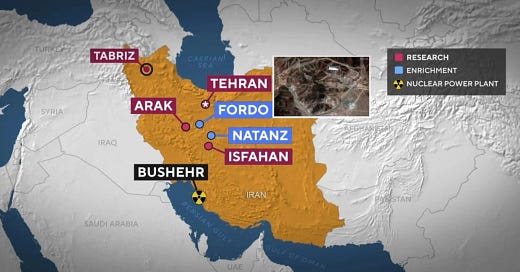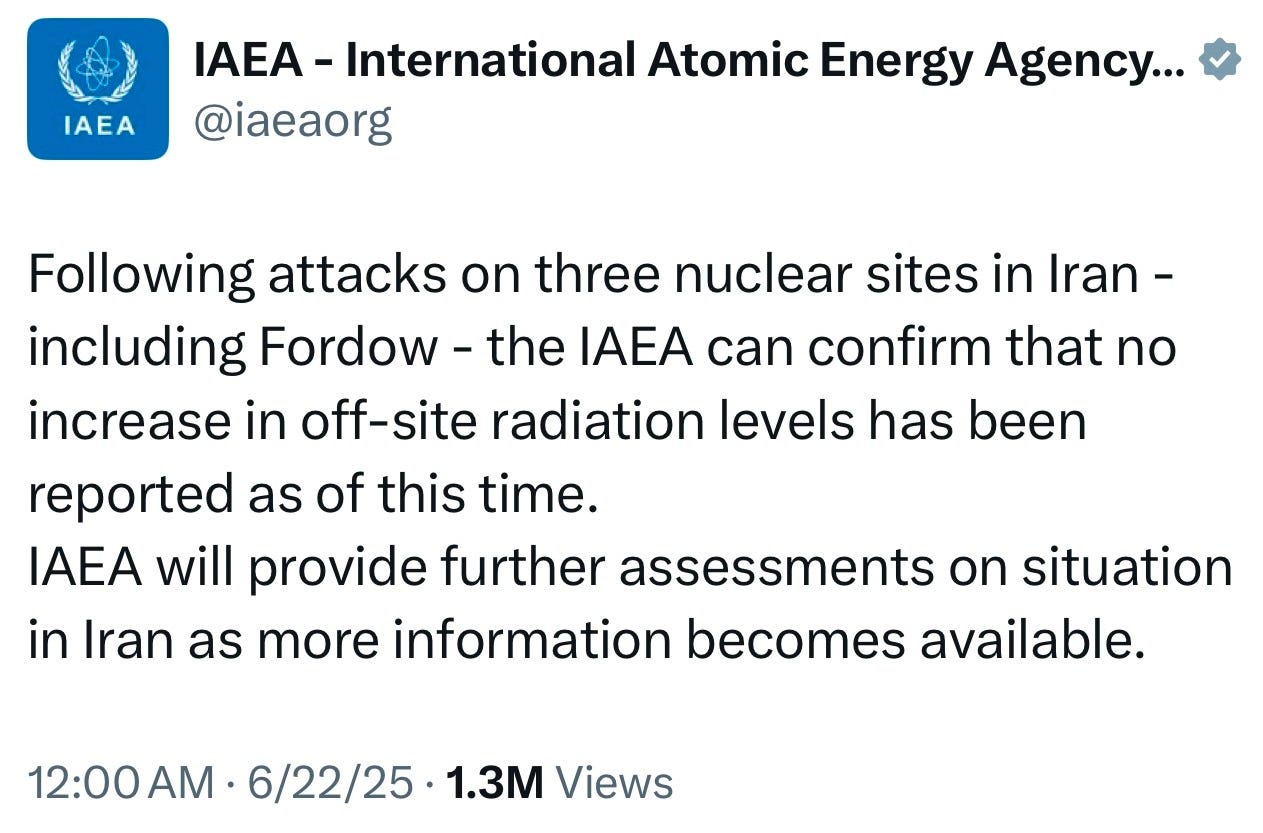Operation Midnight Hammer
After years of planning, the strike on Iran’s nuclear enrichment facilities has finally come to a head, foreshadowed by a practice run conducted just this past March.
In an escalation of tensions in the Middle East, the United States and Israel launched an attack on three of Iran’s most critical nuclear sites in an operation dubbed "Midnight Hammer."
The Strike
On Saturday night, the U.S. military is reported to have carried out airstrikes on three Iranian nuclear sites: Fordow, Natanz, and Isfahan. To reach Fordow, buried deep under a mountain, the American forces used a conventional bunker-busting weapon—the GBU-57 Massive Ordnance Penetrator (MOP)—that can punch through 200 feet of earth or 60 feet of reinforced concrete before detonation.
According to General Dan Caine, Chairman of the Joint Chiefs of Staff, 14 MOPs were used among 75 precision-guided munitions in the operation. Initial assessments indicate that all three facilities sustained “extreme damage and destruction.”
However, a full Battle Damage Assessment (BDA) is still underway.
Iran’s Response: “We Knew It Was Coming”
Iranian officials, including the Atomic Energy Organization and state broadcaster IRIB, claim they had advance warning. They said the sites were cleared of sensitive materials ahead of the strike, minimizing the impact.
This claim gains some credibility from reports that President Donald Trump warned Iran before the strike. Iran has condemned the strikes as a “barbaric violation” of international law. Still, both the UN's International Atomic Energy Agency (IAEA) and Saudi Arabia confirmed that there has been no rise in radiation levels at or near the targeted sites.
The Build-Up: Years in the Making
The groundwork for this operation appears to have been laid since 2021, when Israel was moved from the U.S. European Command to Central Command (CENTCOM) in the Middle East.

From January 23–26, 2023, the U.S. and Israel carried out Juniper Oak 23.2, their largest and most complex joint military exercise to date. The drill involved over 140 aircraft, 12 naval vessels, and extensive land, sea, air, cyber, and space operations across Israel and the Eastern Mediterranean.
CENTCOM described Juniper Oak as a "Combined Joint All-Domain" exercise aimed at enhancing military readiness, interoperability, and regional stability. The training included integrated bomber and fighter missions, close air support, long-range precision strikes, naval operations with the George H.W. Bush carrier strike group, combat search and rescue, and coordination with Space Force satellites.
Among the forces deployed were:
10 F-35 stealth fighters (4 American, 6 Israeli)
4 B-52 bombers from Minot and Barksdale Air Force Bases
180,000 pounds of live munitions
“This is the most significant U.S.-Israel military exercise in history,” said CENTCOM commander Gen. Michael “Erik” Kurilla. “It showcases our ability to rapidly project combat power and strengthens our commitment to Israel and the region.” It also marked the deepening of CENTCOM’s partnership with Israel, which formally joined its area of responsibility in 2021.
In March 2025, the Israel Defense Forces (IDF) and the U.S. Air Force had a joint aerial drill, showcasing coordinated maneuvers between Israeli F-35I and F-15I fighters and an American B-52 strategic bomber.

The military exercise was widely seen as a message to Iran, and Israeli reports suggested it was in preparation for a potential strike on Iranian nuclear facilities. Military officials said the drill emphasized joint operational readiness and enhanced interoperability between the two allies. While specific scenarios remained classified, these drills simulated a real-world mission that would play out just four months later.
Israeli defense analysts told Channel 14 that the Israeli Air Force (IAF) could be ready to strike Iran’s nuclear facilities, including the heavily fortified Fordow site, “within a week” at the time. The U.S. also reportedly positioned up to seven B-2 stealth bombers at Diego Garcia in the Indian Ocean, offering a powerful re-strike option in support of Israeli operations back in March.
Did Israel Drop the Payload?
The B-2 bombers, widely covered in the media, were later revealed to be a decoy for the mission in Iran. It's unclear whether Donald Trump would have been willing to risk the life of an American pilot on an operation perceived as serving Israel's interests more than America's.
Given Israel’s advanced air capabilities, it's entirely plausible that it carried out the strike on Iran’s nuclear facilities despite media reporting. The Israeli Air Force operates upgraded versions of the F-15I “Ra’am” and the F-35I “Adir,” both customized to meet specific operational requirements.
There’s been speculation of secret extended-range F-35 modifications since Israel’s strikes on Iran began this month. Israel has a history of modifying its birds to suit unique military missions. A notable example is the 1981 raid on Iraq’s Osirak nuclear reactor, where they adapted its then-new F-15A Eagle—originally an air superiority fighter—to deliver bombs. This marked the first time the F-15 was used in a strike role. The U.S. could have also given Israel the bunker buster bomb, or maybe they used a smaller classified munition we don’t yet know about. It’s hard to say at this point.
It looks like the United States and Israel have been laying the groundwork for this operation since way back in 2021, right around the time Israel was shifted under U.S. Central Command. So, it’s no real shock that Ayatollah Khamenei made sure any sensitive nuclear material was cleared out before the strike on Fordow. After all, Washington and Tel Aviv have been all but broadcasting their intentions since the massive Juniper Oak military exercise in 2023, not to mention the joint bomber exercise just this past March.
If you have any tips, you know where to hit me up on X (@DCinTejas) or message me on Substack.
-DeAnna Calderón






